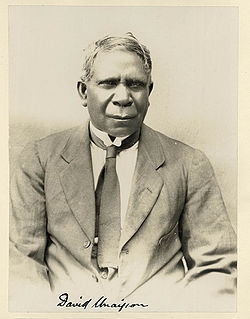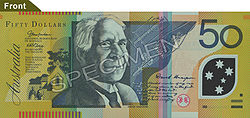- David Unaipon
-
David Ngunaitponi
David Unaipon (Anglicisation)
David Unaipon in the late 1920sBorn 28 September 1872
Point Mcleay MissionDied 7 February 1967 (aged 94)
Tailem Bend, South AustraliaNationality Australian
(Warrawaldie Lakalinyeri of the Ngarrindjeri)Education Raukkan mission school
BootmakerInfluenced by John Milton Spouse Katherine Carter (nee Sumner) Parents Mother: Nymbulda?[1]
Father: James NgunaitponiDavid Unaipon (born David Ngunaitponi) (28 September 1872 – 7 February 1967) was an Australian Aboriginal of the Ngarrindjeri people, a preacher, inventor and writer. He was the most widely known Aboriginal in Australia,[2] and broke stereotypes of Aboriginals. Unaipon is featured on the Australian $50 note in commemoration.
Contents
Biography
Born at Raukkan, South Australia (Point McLeay) Mission on the banks of Lake Alexandrina in the Coorong region of South Australia, Unaipon was the fourth of nine children of James and Nymbulda Ngunaitponi. In 1868 James became the first Aboriginal preacher. Unaipon began his education at the age of seven at the Point McLeay Mission School and soon became known for his intelligence, with the former secretary of the Aborigines' Friends' Association stating in 1887 "I only wish the majority of white boys were as bright, intelligent, well-instructed and well-mannered, as the little fellow I am now taking charge of."[3]
Unaipon left school at the age of 13 to work as a servant for C.B. Young in Adelaide where Young actively encouraged Unaipon's interest in literature, philosophy, science and music. In 1890 he returned to Point Mcleay where he apprenticed to a bootmaker and was appointed as the mission organist.[4] In the late 1890s he travelled to Adelaide but found his colour was a bar to employment in his trade and instead took a job as storeman for an Adelaide bootmaker before returning to work as book-keeper in the Point McLeay store.
On 4 January 1902 he married Katherine Carter (née Sumner), a Tangane woman.[5] He was later employed by the Aborigines' Friends' Association as a deputationer, in which role he travelled and preached widely in seeking support for the Point McLeay Mission.[6] Unaipon retired from preaching in 1959 but continued working on his inventions into the 1960s.[5]
Inventor
Unaipon took out provisional patents for 19 inventions but was unable to afford to get any of his inventions fully patented. His most successful invention (provisional patent 15 624), a shearing machine that converted curvilineal motion into the straight line movement which is the basis of modern mechanical shears, was introduced without Unaipon receiving any financial return and, apart from a 1910 newspaper report acknowledging him as the inventor, he received no credit.[7] Other inventions included a centrifugal motor, a multi-radial wheel and a mechanical propulsion device. He was also known as the Australian Leonardo da Vinci for his mechanical ideas, which included pre WWI drawings for a helicopter design based on the principle of the boomerang and his research into the polarisation of light and harnessing the secret of perpetual motion.[8]
Writer and lecturer
Unaipon was obsessed with correct English and in speaking tended to use classical English rather than that in common usage. His written language followed the style of Milton.[6]
Unaipon was inquisitively religious, believing in an equivalence of traditional Aboriginal and Christian spirituality. His employment with the Aborigines' Friends' Association collecting subscription money allowed him to travel widely. The travel brought him into contact with many intelligent people sympathetic with the cause of Aboriginal rights, and gave him the opportunity to lecture on Aboriginal culture and rights. Although he was much in demand as a public speaker he was often refused accommodation and refreshment due to his race.
Unaipon was the first Aboriginal writer to publish in English,[9] the author of numerous articles in newspapers and magazines, including the Sydney Daily Telegraph, retelling traditional stories and arguing for the rights of Aboriginals.
Some of Unaipon's traditional Aboriginal stories were published in a 1930 book, Myths and Legends of the Australian Aboriginals, under the name of anthropologist William Ramsay Smith.[10] They have recently been republished in their original form, under the author's name, as Legendary Tales of the Australian Aborigines.[11]
Other
Unaipon was a recognised authority on ballistics.[7]
Unaipon was also a researcher and witness for the Bleakley Enquiry into Aboriginal Welfare and lobbied the Australian Government to take over responsibility for Aboriginals from its constituent states.
In 1936, he was reported to be the first Aboriginal to attend a levée, when he attended the South Australian centenary levée in Adelaide, an event that made international news.[12]
Unaipon proposed to the government of South Australia to replace the office of Chief Protector of Aborigines with a responsible board. He was arrested for making an attempt to provide a separate territory for Aboriginals in Central and Northern Australia.
Unaipon returned to his birthplace in his old age, where he worked on inventions and attempted to reveal the secret of perpetual motion. The last full-blooded member of the Portaulun (Waruwaldi) tribe,[13][14] Unaipon died in the Tailem Bend Hospital on 7 February 1967 and was buried in the Raukkan (formerly Point McLeay) Mission Cemetery.[5] He was survived by a son.
Legacy and tributes
An interpretive dance based on Unaipon's life, Unaipon, was performed by the Bangarra Dance Theatre,[15] while the David Unaipon Literary Award is an annual award presented for the best of writing of the year by unpublished Aboriginal and Torres Strait Islander authors.[16]
The David Unaipon College of Indigenous Education and Research at the University of South Australia is named after him,[17] as is Unaipon Avenue in the Canberra suburb of Ngunnawal.[18]
Fifty-dollar note
Allan "Chirpy" Campbell, reported to be the great-nephew of David Unaipon, failed in an attempt to negotiate a settlement with the Reserve Bank of Australia for using an image of Mr Unaipon on the Australian $50 note without the permission of the family. Mr Campbell's argument was that the woman (now deceased) originally consulted by the Reserve Bank was not related to Mr Unaipon.[19]
Works
- David Unaipon; Legendary Tales of the Australian Aborigines. Melbourne: Melbourne University Press. ISBN 0-522-84905-9.
See also
References
- Gale, M. (1997) Dhanum Djorra'wuy Dhawu: A history of writing in Aboriginal languages, Aboriginal Research Institute, Underdale, South Australia. ISBN 0-86803-182-8.
- Jenkin, G. (1979). Conquest of the Ngarrindjeri, Rigby. ISBN 072701112X
Sources
- ^ Berndt, Berndt and Stanton (1993). A world that was: the Yaraldi of the Murray River and the lakes, South Australia. Pg 515-516: University of British Columbia Press. ISBN 0774804785.
The only primary source for the name Nymbulda is George Taplin. The Yaraldi genealogy compiled by Ronald Berndt names her as Nymberindjeri with Nymbulda being her fathers first wife and there was also another of that name married to another relative. It can not be ruled out that she was known by both names. Indigenous tradition required that following a death, the deceased persons name could no longer be used and those with the same name would take a new name. - ^ Graham Jenkin, Conquest of the Ngarrindjeri, The Story of the Lower Murray lakes Tribes,(1979)1985 Rigby reprint p.185
- ^ Jenkin, p. 185.
- ^ David Unaipon Preacher, Inventor, Musician & Writer History Trust of South Australia
- ^ a b c Unaipon, David (1872 - 1967) Australian Dictionary of Biography
- ^ a b Unaipon, David (1872 - 1967) Webjournals
- ^ a b Jenkin, pp. 234-236
- ^ "On the shore of a strange land: David Unaipon". Australian Broadcasting Corporation. http://www.abc.net.au/rn/awaye/stories/2009/2489556.htm. Retrieved 26 February 2009.
- ^ Gale (1997), p. 41.
- ^ Miller, Ben. Confusing Epistemologies: Whiteness, Mimicry and Assimilation in David Unaipon's 'Confusion of Tongue'. Altitude, Vol. 6.
- ^ Unaipon, D. (2006) Legendary Tales of the Australian Aborigines, Melbourne: Melbourne University Press. ISBN 0-522-85246-7.
- ^ The Times of London, "Australian Aboriginal At Lev.eé", 24 June 1936, p. 15.
- ^ "Tindale Tribes-Portaulun". South Australian Museum. http://samuseum.australia.sa.com/tindaletribes/portaulun.htm. Retrieved 8 December 2010.
- ^ David Unaipon claimed Portaulun was the name of the language spoken by his people and that the lakinyeri (tribe) name was Waruwaldi
- ^ Whitehorn, Zane "The legacy of David Unaipon", Indigenous Newslines, March–May 2010, p. 16.
- ^ "Rookie writer Amy Barker joins literati". The Australian. http://www.theaustralian.news.com.au/story/0,25197,26047164-16947,00.html. Retrieved 16 October 2009.
- ^ The David Unaipon College of Indigenous Education and Research
- ^ "Unaipon Avenue". ACT Planning and Land Authority. http://www.actpla.act.gov.au/tools_resources/maps_land_survey/place_names/place_search?sq_content_src=%2BdXJsPWh0dHAlM0ElMkYlMkZ3d3cuYWN0bWFwaS5hY3QuZ292LmF1JTJGUGxhY2VOYW1lcyUyRlBsYWNlRGV0YWlscy5hc3B4JTNGb2JqZWN0SUQlM0QxMDI5MCZhbGw9MQ%3D%3D. Retrieved 11 November 2010.
- ^ "Family wants compo for $50 note image", Larine Statham, AAP, 27 November 2008, appearing at news.com.au, accessed 28 November 2008.
External links
- Biographical notes by Bangarra Dance Theatre choreographer Frances Rings
- David and James Unaipon at Unaipon School, University of South Australia
- The David Unaipon Award at University of Queensland Press
- Legendary Tales Digital Art Exhibition
- David Unaipon online collection - State Library of NSW
- Radio documentary On the shore of a strange land: David Unaipon
- Jones, Philip (1990). "Unaipon, David (1872 - 1967)". Australian Dictionary of Biography. Canberra: Australian National University. http://www.adb.online.anu.edu.au/biogs/A120339b.htm. Retrieved 13 January 2009.
Categories:- 1872 births
- 1967 deaths
- Australian inventors
- Australian short story writers
- Indigenous Australian people
- Indigenous Australian writers
- Jubilee 150 Walkway
- Ngarrindjeri
Wikimedia Foundation. 2010.

